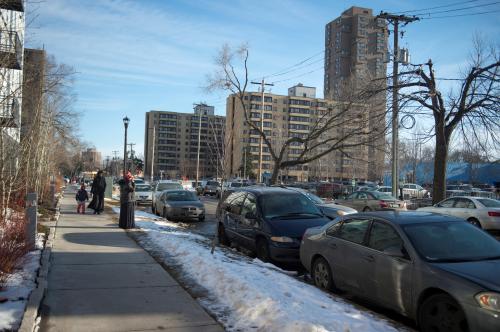If you want more content like this, subscribe to our newsletter.
This week in Class Notes:
-
- Improving economic opportunity for immigrant girls can negatively affect life satisfaction and self-esteem.
- Greater accessibility of public 2-year universities improves health behaviors and outcomes in adulthood.
- Top-of-the-line firms in the United States provide fewer fully paid parental weeks than the median OECD nation.
- Our top chart shows that rates of absolute intergenerational mobility have fallen precipitously in recent years and that most of this decline is attributable to inequity in income gains, rather than lower rates of economic growth.
- Shaun Donovan argues for the importance of protecting the Fair Housing Act.
- Finally, check out Isabelle Sawhill and Chris Pulliam’s new piece on the role of healthcare subsidies in middle-class income trends.
The unintended consequences of improving opportunity for immigrant girls
What happens when immigrant girls are given increased opportunities to integrate into the workplace and society, but their parents value more traditional cultural outcomes? Focusing on a reform that granted automatic birthright citizenship to eligible immigrant children born in Germany after January 1, 2000, Dahl et al. find that the reform lowers measures of life satisfaction and self-esteem for immigrant girls. This is especially true for Muslims, where traditional cultural identity is particularly salient. Birthright citizenship results in disillusionment where immigrant Muslim girls believe their chances of achieving their educational goals are lower, and the perceived odds of having to forgo a career for family rise. Consistent with this theory, immigrant Muslim parents invest less in their daughters’ schooling and have a lower probability of speaking German with their daughters if they are born after the reform.
Muslim girls granted birthright citizenship are less likely to self-identify as German, are more socially isolated, and are less likely to believe foreigners can have a good life in Germany. In contrast, immigrant boys experience suggests an improvement in well-being. Taken together, the findings point to immigrant girls being pushed by parents to conform to a role within traditional culture, whereas boys are allowed to take advantage of the opportunities that come with citizenship.
College access and adult health
In this study, Cowan et al. examine whether an increase in 2- and 4-year institutions per capita contributes to higher college attainment and better health later in life. The authors find consistent evidence that accessibility of public 2-year institutions positively affects schooling attainment and subsequent employment and earnings levels, particularly among whites and Hispanics. Additionally, public 2-year accessibility benefits a host of health behaviors and outcomes in adulthood: it deters smoking, raises exercise levels, and improves self-reported health. However, most long-term health conditions are unaffected.
Why firms offer paid parental leave: An exploratory study
Why do competitive firms in the United States provide paid parental leave? Which firms do and to what extent? In this paper, Goldin et al. use BLS-Employee Benefit Survey data to address these questions. The authors find that firm-provided paid parental leave has greatly increased in the last two decades and generally covers new fathers. The levels of provision differ greatly by the industry, firm size, and the degree of firm-specific training. But even the top-of-the-line firm in the U.S. provides fewer fully paid parental weeks than does the median OECD nation.
Top chart
This week’s top chart shows that patterns of economic growth that increase income inequality also make it more difficult for people to pull themselves up the rungs of the income ladder. Indeed, at age 30, people born in 1940 had an approximately 90 percent chance of out earning their parents. But for people born in 1980, the chances were just 50 percent.

Choice opinion
“This month, HUD issued a proposal that would largely strip away the expectation that communities provide housing that fights segregation and increases opportunity, weaken penalties, and reinstate a discredited enforcement process. These proposed rules are reckless and wrong…housing plays a key role in advancing economic opportunity and closing the wealth gap between people of color and white Americans. African-Americans and Latinos have less than one-tenth and one-eight, respectively, of the household wealth of white Americans, and homeownership remains the largest source of wealth-building for most families.”
“Moreover, where a family lives determines access to jobs, schools, and a health environment. If we believe our children’s futures shouldn’t be determined by the ZIP code where they grow up, we need the disparate impact and affirmatively furthering standards to weed out and replace unjustifiable policies that limit opportunity” writes Shaun Donovan in the New York Times.
Self-promotion
As we have shown before, income growth for the middle class is falling behind both the bottom and the top. Based off the Congressional Budget Office’s measure of income, middle-class incomes grew 47 percent from 1979 to 2016, while the top 20 percent saw their incomes double and the bottom 20 experienced 84 percent growth.
In their new piece “Middle class income growth is lagging the rich and the poor – how much is due to healthcare subsidies?,” Isabelle Sawhill and Chris Pulliam examine the role of healthcare subsidies in explaining this trend, and provide additional evidence that the middle class is experiencing a lack of robust income growth relative to both the bottom and the top.








Commentary
Class Notes: College access, paid parental leave, and more
Wednesday, January 29, 2020